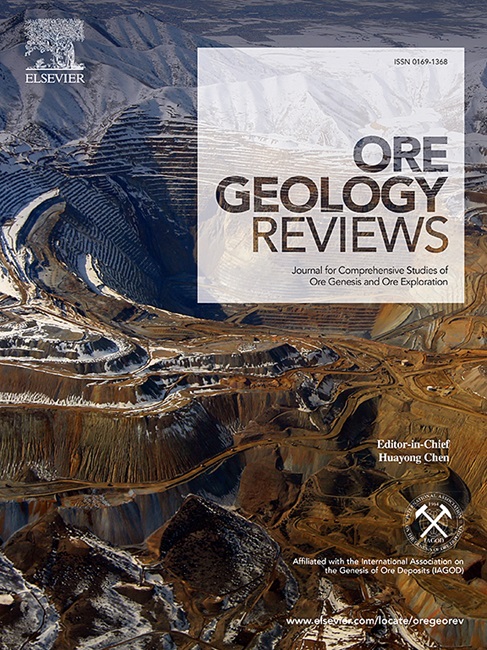Multi-stage granite and granitic pegmatites in the eastern North Qinling orogen: Petrogenesis, geodynamic setting, and metallogenic potential
IF 3.2
2区 地球科学
Q1 GEOLOGY
引用次数: 0
Abstract
Numerous granitic pegmatite dikes intrude the Wuduoshan batholith in the eastern North Qinling orogen (NQ). However, the petrogenesis, interrelationships, and geodynamic setting of these granitoids and associated dikes remain poorly understood. This study investigates the Erlangchuan and Sikeshu plutons and their related dikes in the Qinling orogen, central China, through integrated petrographic, whole-rock geochemical, zircon U-Pb geochronological, and Lu-Hf isotopic analyses. Zircon U-Pb dating yielded crystallization ages of 430.8 ± 2.0 Ma for the Erlangchuan monzogranites, 415.2 ± 1.7 Ma for associated biotite granitic pegmatites, 416.9 ± 2.2 Ma for associated aplite dikes, and 403.6 ± 4.7 Ma for Sikeshu muscovite granitic pegmatites. All samples display geochemical characteristics consistent with a crustal origin, showing enrichment of large-ion lithophile elements (LILE; e.g., Rb, Th, Ba, and Cs) and depletion of high field strength elements (HFSE; e.g., Nb, Ta, and Ti). The granitic dikes exhibit higher SiO2 contents compared to their respective host plutons: the K-rich Erlangchuan monzogranites and the Na-rich, two-mica Sikeshu granites. Zircon Lu-Hf isotopic data reveal higher εHf(t) values for the Erlangchuan monzogranites (average = +2.6) compared to the associated biotite pegmatites (+2.0), aplites (+1.6), and the Sikeshu muscovite pegmatites (+0.9). The εHf(t) values of both plutons and their dikes fall between those of the Qinling Group and juvenile mafic crust, suggesting derivation from a mixed source. Variations in εHf(t) values likely reflect differing proportions of these two endmembers. The Erlangchuan monzogranites formed via partial melting of the lower crust, triggered by mafic magma underplating during Shangdan Ocean subduction. The Sikeshu two-mica granites, associated aplites, and biotite pegmatites likely formed during subsequent collision and slab break-off. Finally, the Sikeshu muscovite pegmatites may represent a later magmatic pulse related to post-collisional lithospheric delamination. Regionally, granitic pegmatites in the eastern NQ define three distinct age peaks at 437 Ma, 413 Ma, and 367 Ma. These pegmatites can be broadly classified into two series: (1) a rare metal-bearing series, predominantly located in the northern eastern NQ, enriched in Nb, Ta, Be, Rb, Li, and Cs, and characterized by negative εHf(t) values indicative of a Qinling Group source; and (2) a U-bearing series, primarily found in the southern eastern NQ, positive or slightly negative εHf(t) values, suggesting derivation from a mixed Qinling Group and juvenile crustal source.

求助全文
约1分钟内获得全文
求助全文
来源期刊

Ore Geology Reviews
地学-地质学
CiteScore
6.50
自引率
27.30%
发文量
546
审稿时长
22.9 weeks
期刊介绍:
Ore Geology Reviews aims to familiarize all earth scientists with recent advances in a number of interconnected disciplines related to the study of, and search for, ore deposits. The reviews range from brief to longer contributions, but the journal preferentially publishes manuscripts that fill the niche between the commonly shorter journal articles and the comprehensive book coverages, and thus has a special appeal to many authors and readers.
 求助内容:
求助内容: 应助结果提醒方式:
应助结果提醒方式:


